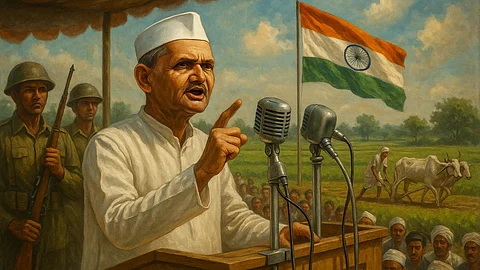
- Home
- न्यूजग्राम
- India
- World
- Politics
- Entertainment
- Culture
- Lifestyle
- Economy
- Sports
- Sp. Coverage
- Misc.
- NewsGram Exclusive
- Jobs / Internships

(This article was first published on July 27, 2025)
Lal Bahadur Shastri was appointed as the Prime Minister of India on June 9, 1964.
Shastri urged Indians to voluntarily skip one meal a week to reduce dependence on imported wheat.
He supported the White Revolution to boost milk production and supply.
Lal Bahadur Shastri Jayant 2025: Lal Bahadur Shastri was a prominent historical figure whose contributions to the welfare of the Indian people marked him as a humble and resolute political leader. He led the nation with integrity, impartiality, and dedication. Shastri held the office of Prime Minister for a short period, from 1964 to 1966, yet his contributions were vast and influential.
Lal Bahadur Srivastava was born on October 2, 1902, in Mughalsarai, Uttar Pradesh. He was deeply influenced by Mahatma Gandhi and Swami Vivekananda. At the age of 21, he dropped his caste-associated surname and adopted “Shastri” as his new name. After India’s independence in 1947, Shastri was appointed as the Minister of Railways and Transport on May 13, 1952. He resigned from the position after the 1956 Ariyalur train accident, which resulted in at least 140 deaths. Shastri took moral responsibility for the accident and resigned from the post in December 1956.
In 1959, he served as the Minister of Commerce and Industry and later became the Minister of Home Affairs in 1961 under the government of Prime Minister Jawaharlal Nehru.
After the death of Jawaharlal Nehru on May 27, 1964, India faced several political and economic challenges, including the aftermath of the 1962 war with China, a growing food crisis, and rising aggression from Pakistan. Shastri was unanimously voted by congress members and on June 9, 1964, he was named the Prime Minister of the Republic of India. Despite these tough challenges, Shastri firmly took the reins of leadership and worked towards strengthening the nation by bringing its people together.
Shastri, a Nehruvian socialist, promoted the economic policies of self-sufficiency and self-reliance previously initiated by Nehru. He supported the White Revolution to boost milk production and supply, particularly by supporting Amul Milk. This initiative led to the establishment of the National Dairy Development Board (NDDB) in 1965, founded by Dr. Verghese Kurien.
In the 1960s, India faced chronic food shortages due to widespread droughts, failed monsoons, and a rising population. As a result, India became a major recipient of U.S. aid under Public Law 480 (PL-480), also known as the “Food for Peace” program, initiated in 1954 by U.S. President Dwight D. Eisenhower to address surplus agricultural commodities and promote international goodwill.
However, heavy dependence on American wheat created political pressure for India to align with U.S. interests, particularly concerning the Vietnam War and India’s relations with the Soviet Union. At the time, U.S. President Lyndon B. Johnson threatened to withhold food aid because India took a neutral stance and openly criticized U.S. involvement in the Vietnam War.
In response, Shastri appealed to the people of India to voluntarily give up one meal a week to reduce the country’s dependency on American wheat. Remarkably, before making this appeal, Shastri tested it within his own household, asking his family to skip a meal to see if they could withstand the hunger.
See Also:
During the war with Pakistan in 1965, Shastri delivered his historic slogan “Jai Jawan, Jai Kisan” (“Hail the Soldier, Hail the Farmer”) at Urwa, Allahabad, on October 19, 1965. This slogan became a national call, recognizing the role of soldiers in protecting the nation and farmers in feeding it.
To tackle the food shortage crisis, Shastri promoted the Green Revolution, focusing on high-yielding variety seeds, improved irrigation systems, and modern farming techniques. The Green Revolution was highly successful, especially in states like Punjab, Haryana, and Uttar Pradesh, and reduced India’s reliance on foreign imports.
Shastri faced multiple crises while promoting India’s strong position against Pakistan during the war. On August 1, 1965, Pakistan launched covert attacks aimed at inciting revolt in Kashmir, which failed. India responded by sending its forces to the Line of Control, which escalated the conflict by crossing the International Border near Lahore. This triggered a full-scale war.
While Pakistani forces advanced in the north, Indian troops captured the strategic Haji Pir Pass in Kashmir and brought Lahore under heavy artillery and mortar fire. The 22-day war concluded on September 23, 1965, following a ceasefire mandated by the United Nations.
On January 10, 1966, a peace agreement (Tashkent Agreement) was signed between Lal Bahadur Shastri and Pakistan’s President Mohammad Ayub Khan in Uzbekistan. Shockingly, just a day later, on January 11, 1966, Lal Bahadur Shastri died of a heart attack.
His sudden death gave rise to several unanswered questions and conspiracy theories. Although Indian and foreign doctors confirmed heart failure as the cause, doubts persisted. The Shastri family demanded a post-mortem, but the government, relying on medical reports, declined, officially ruling heart attack as the cause of death.
Questions remain to this day: Was it a natural death, or are the conspiracy theorists right about Shastri being poisoned? The mystery inspired films like The Tashkent Files and led to multiple RTI petitions, but official responses have been inconclusive. [Rh/VS]
Also Read:
